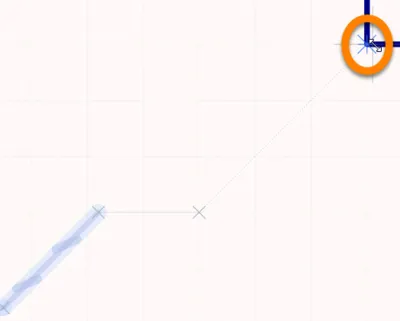Signal Harnesses are available for placement in the Schematic Editor only in one of the following ways:
- Choose Home | Circuit Elements | Harnesses » Signal Harness from the main menus.

- Right-click in the design space then choose Place » Harness » Signal Harness from the context menu.
After launching the command, the cursor will change to a cross-hair and you will enter signal harness placement mode. Placement is made by performing the following sequence of actions:
- Click or press Enter to anchor the starting point for the signal harness.
- Position the cursor then click or press Enter to anchor a series of vertex points that define the shape of the signal harness.
- After placing the final vertex point, right-click or press Esc to complete placement of the signal harness.
- Continue placing further signal harness objects or right-click or press Esc to exit placement mode.
- Use the Backspace or Delete keys to remove the last harness segment placed.
While attributes can be modified during placement, keep in mind that these will become the default settings for further placement.
When placing a signal harness there are three 'manual' placement modes, two of which have Start and End sub-modes. The mode specifies how corners are created when placing signal harnesses and the angles at which signal harnesses can be placed. During placement:
- Press Shift+Spacebar to cycle through the 90 Degree, 45 Degree and Any Angle modes.
- While in the 90 Degree or 45 Degree mode (known as true orthogonal modes), press Spacebar to cycle between the Start and End sub-modes.
- During placement, the current placement mode is displayed in the Status bar. You can change modes at any time during signal harness placement.
- In modes other than Any Angle, the line segment attached to the cursor is a look-ahead segment. The segment you are actually placing precedes this look-ahead segment.
 45 degree mode
45 degree mode
 90 degree mode
90 degree mode
 Any angle mode
Any angle mode
Press Shift+Spacebar to cycle through the different placement modes.
Guided Wiring of a Signal Harness
Schematics have a definable electrical grid that makes it easy to define electrical connections between objects. As you are placing a Signal Harness, when the Signal Harness falls within the electrical grid range of another electrical object, the cursor will snap to the fixed object and a Hot Spot (blue cross) will appear.

Hot Spot (blue cross)
The Hot Spot guides you to where a valid connection can be made and automatically snaps the cursor to electrical connection points.
The electrical grid can be defined on the General tab in the Inspector panel in Document Options mode (Project | Content | Document Options). It is recommended that you set the electrical grid to be slightly smaller than the current snap grid or it becomes difficult to position electrical objects one snap grid apart.
Break Wire can be used to break a segment of a signal harness into two pieces at a chosen location on the schematic sheet. Refer to the
Wire page for information regarding break wires.
Graphical Editing
This method of editing allows you to select a placed signal harness object directly in the design space and change its size and/or shape graphically.
When a signal harness object is selected, the following editing handles are available:

Selected Signal Harness, ready for graphical editing
- Click and drag A to reposition the endpoints of the signal harness.
- Click and drag B to move a signal harness vertex. The endpoints will remain anchored.
- Ctrl+click and drag on a segment to grab that segment and reposition it. The endpoints and other vertices will remain anchored.
- Right-click on a vertex point and choose the Edit Signal Harness Vertex n command to open the Vertices region of the Signal Harness mode of the Inspector panel, with the entry for the
nth vertex selected ready for editing.
- Ctrl+click and hold on a segment then press Insert on the keyboard to add a vertex at that point.
- Click and hold on a vertex then press Delete on the keyboard to remove that vertex.
To move an entire signal harness, click and hold on the unselected signal harness (or click and hold on the selected signal harness, away from vertices) then move to the new location.
Non-Graphical Editing
This method of editing uses the Inspector panel mode to modify the properties of an object.

During placement, the Signal Harness mode of the Inspector panel can be accessed by pressing the Tab key. Once the object is placed, all options appear.
After placement, the Signal Harness mode of the Inspector panel can be accessed in one of the following ways:
- If the Inspector panel is already open, select the object, right-click then choose Properties from the context menu.
- With the port selected, choose View | Schematic | Inspector from the main ribbons.
Editing Multiple Objects
The Inspector panel supports multiple object editing in which the property settings that are identical in all currently selected objects may be modified. When multiples of the same object type are selected manually, an Inspector panel field entry that is not shown as an asterisk (*) may be edited for all selected objects.